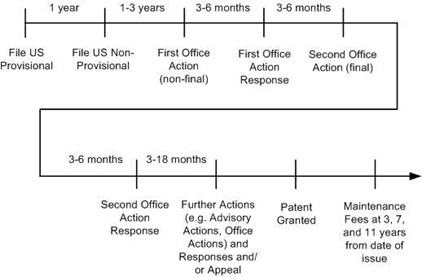
Overview of Prosecution
The following is a very global view timeline of the prosecution process. Again, this is not intended to be exhaustive. Rather, it is simply to get you aligned to where you are in the entire process quickly.

Using this global timeline, let’s briefly discuss the milestones in this process.
- Grace Periods: The calendar starts to tick whenever a public disclosure is made. Remember that once a public disclosure is given, you have one year to get an application on file (either provisional or non provisional). Recognize also that a disclosure may preclude protection in some foreign jurisdictions.
- Filing Dates: The non provisional application needs to be filed within one year of the disclosure or within one year of the provisional application. Additionally, a PCT application will need to be filed within one year of the provisional application.
- First Office Action: Normally, the USPTO goal is get this out within one year of the filing. However, recognize there is a backlog and so it may be much longer before it is received. Very few applications are ever granted before receiving a first office action.
- First Office Action Response: Within three months of receiving the Office Action, a response must be filed. Recognize that although extensions are available, it will cost more money.
- Second Office Action: The patent examiner will review the response and may issue a second Office Action (e.g. non final, final, etc.). The process will continue until a patent is issued, the patent application is abandoned or if a final rejection of the application is issued.
- Granted: In an ideal world, an applicant receives a non-final office action, amends the claims, receives a final office action response, responds, and then the claims are granted.
- 18 Month Milestone: Eighteen months after filing a non-provisional or PCT patent application, the application is published.
- 30 Month Milestone: Within 30 months after filing the PCT application, the individual countries (if any) in which patent protection need to be designated. .
- Maintenance Fees: Once the U.S. Patent has been issued, patent maintenance fees are due at 3, 7 and 11 years after issuance.
- Termination: The Patent expires 20 years from the non-provisional application filing date. At this point, the invention enters the public domain.
Of course, it should be noted that each case may proceed a bit differently. You may have two non-final office actions before you receive a final office action. Following the final office action, your matter may still not be granted, in which case you would need to explore a continuation potentially. As such, the foregoing chart is just a possible example of how the prosecution process may proceed.
